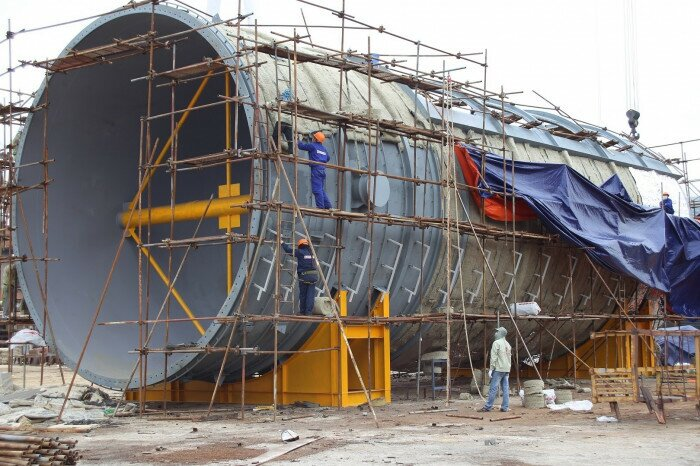The LNG fever caused the Korean shipbuilding industry to “revive”, orders booked for the next 2 years, having to resort to Southeast Asia
13/04/2023Change in the port city
A major change is taking place in the shipbuilding hub southwest of Busan.
At Asia DC Mart supermarket, a series of imported goods have just arrived. The manager of the store, which already supplies 200 kinds of spices, is thinking about expanding its product portfolio further to accommodate the rapid increase of foreign workers in the area.
This is the result of the Korean government’s greater opening to foreign workers – mainly from Southeast Asia – amid a severe shortage of shipbuilders.
According to South Korea’s Ministry of Trade, Industry and Energy, about 2,000 foreigners were brought into shipyards across the country this month.
The 400 square kilometer Geoje island is home to the shipyards of Samsung Heavy Industries and Daewoo Shipbuilding & Marine Engineering, the world’s 3rd and 4th largest shipbuilders, along with a number of subcontractors.
It once boasted the highest gross regional product in Korea during its heyday about 10 years ago. This is also the boom period of the industry before cooling down.
The island has undergone a transformation since the South Korean government eased visa requirements for workers and began speeding up the application process last fall.
These changes brought a large influx of welders, painters and other field workers.
Geoje City, which includes Geoje Island and neighboring islands, has a population of about 230,000. The number of foreign residents arriving this year is expected to increase 150% from 2022 to 5,000.
Samsung Heavy is employing 80 Indonesian workers this year at its Geoje facility.
Korean shipbuilding industry meets times
Orders are now very high due to strong demand for liquefied natural gas (LNG) tankers, partly due to Russia’s special military operation in Ukraine.
The conflict in Ukraine has turned European gas suppliers away from Russian gas brought in via land pipelines and opting for imported LNG from the Middle East and Southeast Asia.
Korean shipbuilders account for 90% of the global market for LNG carriers due to their high level of expertise.
At every shipyard run by the three major companies – Samsung Heavy, Daewoo Shipbuilding and Hyundai Heavy Industries – shipbuilding schedules have been closed until the end of 2025.
According to UK market survey firm Clarksons Research, orders for LNG tankers increased 2.3-fold last year. In which, Korean shipbuilders account for about 70% of the demand and the rest is shipped to China.
However, the industry lacks the workforce to meet the sudden spike in demand.
Geoje Island, where the shipyards are located, is far from Seoul, making it difficult to attract young people. Additionally, the city of Geoje now has an average age of 41.7 – a sharp increase from 35.4 a decade ago.
Foreign workers with sought-after skills can expect at least 80% of local workers’ wages, while the government also offers incentives that add to its appeal.
Leading the global shipbuilding industry today is China State Shipbuilding Corp., a state-owned enterprise. According to Nikkei, with Japanese shipbuilders largely lagging behind their rivals, Korean companies remain the only players able to compete with the growing size of Chinese businesses.
Source: CafeF
Must Read
You may be interested in


Priority is given to investing in 29 seaport projects with a total capital of over 31 trillion Vietnamese Dong sourced from the state budget

Ba Ria – Vung Tau to become national marine economic hub

Improving the capacity of shipbuilding enterprises, catching the wave of opportunities

Completing negotiations and signing power purchase agreements with 40/40 transitional renewable energy investors

Vietnam expected to emerge as a prominent logistics player in Asia

Freight transportation from Ho Chi Minh City port to Barion Head port

Ho Chi Minh City orients to develop Can Gio “superport”

The maritime industry strives for green transformation








